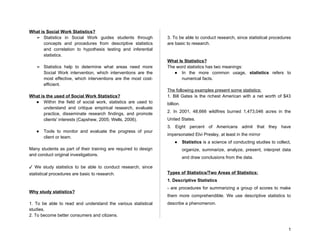BACHELOR of SOCIAL WORK STATISTICS REVIEWER
- 1. What is Social Work Statistics? ➢ Statistics in Social Work guides students through concepts and procedures from descriptive statistics and correlation to hypothesis testing and inferential statistics. ➢ Statistics help to determine what areas need more Social Work intervention, which interventions are the most effective, which interventions are the most cost- efficient. What is the used of Social Work Statistics? ● Within the field of social work, statistics are used to understand and critique empirical research, evaluate practice, disseminate research findings, and promote clients' interests (Capshew, 2005; Wells, 2006). ● Tools to monitor and evaluate the progress of your client or team. Many students as part of their training are required to design and conduct original investigations. ✓ We study statistics to be able to conduct research, since statistical procedures are basic to research. Why study statistics? 1. To be able to read and understand the various statistical studies. 2. To become better consumers and citizens. 3. To be able to conduct research, since statistical procedures are basic to research. What Is Statistics? The word statistics has two meanings: ● In the more common usage, statistics refers to numerical facts. The following examples present some statistics: 1. Bill Gates is the richest American with a net worth of $43 billion. 2. In 2001, 48,666 wildfires burned 1,473,046 acres in the United States. 3. Eight percent of Americans admit that they have impersonated Elvi Presley, at least in the mirror ● Statistics is a science of conducting studies to collect, organize, summarize, analyze, present, interpret data and draw conclusions from the data. Types of Statistics/Two Areas of Statistics: 1. Descriptive Statistics - are procedures for summarizing a group of scores to make them more comprehendible. We use descriptive statistics to describe a phenomenon. 1
- 2. 2. Inferential Statistics -are procedures that help researchers draw conclusions based on informational data gathered. Researchers use inferential statistics when they want to make inferences that extend beyond the immediate data alone. ● Descriptive statistics is concerned with describing numbers and the relationships between them. are procedures for summarizing a group of scores to make them more comprehendible. ● Inferential statistics is concerned with analyzing numbers and drawing conclusions from them. Fundamental Elements of Descriptive Statistics. ➢ Data ➢ Data point ➢ Variable If you collect the ages of five people: - Ruth: 35 years - John: 42 years - Julie: 57 years - Andy: 27 years - Jill: 33 years Data: 35 y.o., 42 y.o., 57 y.o, 27 y.o., 33 y.o (ages of five people) Data point: point each particular number, example 35 Variable: Age A variable is any entity that can take on different values. ● Examples: sex, test scores, height, political party affiliation, IQ, temperature, marital status, age area, etc. Major Types/Classification of Variables: 1. Numerical-Valued/Quantitative Variables - numeric (e.g., test score, height, etc.) 2. Categorical/Qualitative Variables - non numeric or categorical (e.g., sex, political party affiliation, etc) Major Types/Classification of Quantitative Variables 1. Discrete Variables - values are obtained by counting EXCEPT test scores. Examples: Number of dependents, number of students in a classroom, etc. 2. Continuous Variables 2
- 3. - assume an infinite value between any two specific values. They are obtained by measuring. They are often include fractions and decimals. Examples: height, temperature, etc Measurement Scales - has important implications for the type of statistical procedures. (a) nominal (b) ordinal (c) interval (d) ratio (a) Nominal Scale: classifies elements into two or more categories or classes. The categories cannot be ordered. We CAN NOT talk in terms of which variable has less and which has more. Examples: 1. Religion (Christian, Jewish, Islam, Other) 2. Gender (Male, Female) Note: These are qualitative data. (b) Ordinal Scale: classifies data into categories that can be ranked; however, precise differences between the ranks do not exist. We can talk in terms of which variable has less and which has more. Examples: 1. The socioeconomic status (poor, middle class, rich) 2. Ratings (excellent, good, average, below average, poor) (c) Interval Scale: ranks data, and, establishes a uniform unit in the scale so that any distance between two consecutive scores is of equal magnitude. Example: 80 to 90 and 90 to 100 (both being equal to 10). - there is no meaningful zero. For example, a place where the temperature reading is 0 degree Celsius does not mean that there is no temperature in that place. (d) Ratio Scale: all the characteristics of the preceding variables in addition to a true (or absolute) zero point on a measurement scale. Examples: 1. Weight (in pounds) 2. Height (in inches) 3. Distance (in yards) 4. Speed (in miles per hour) 3


